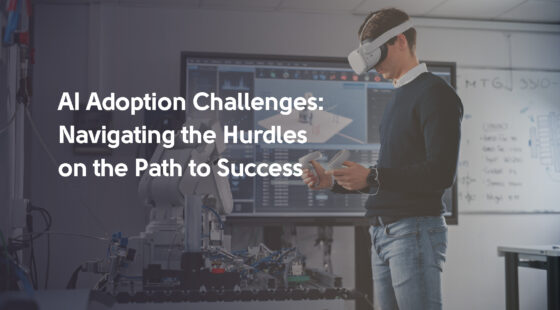Artificial intelligence and machine learning have already become essential components of many business processes across various industries. But progress is unstoppable, which makes the next step inevitable – integrating AI agents in business. Yes, their main goal is to ease the burden of business tasks on people, which is great. But technological advancement always goes hand in hand with its own set of challenges, so the key questions remain:
- How can AI agents be seamlessly integrated into existing business processes?
- Is it safe to delegate business tasks involving data processing to a machine?
- Does one need to be an AI expert to deploy agents?
These and many related questions naturally arise when implementing technological innovations. In this article, we’ll walk you through the concept of AI agents, their business value, the most common challenges associated with implementing smart agents, and effective solutions to overcome these obstacles.
The Role of AI Agents in Business
Let’s start with the basics: what does an AI agent do?
IBM defines an AI agent as a system or program that can independently carry out tasks for a user or another system by creating its own workflow and using available tools.
At its core, their approach can be summarized as follows: smart agents observe, plan, and act, which includes collaboration and self-refinement. Namely, they:
- Continuously gather and process data, such as performance metrics or user engagement
- Use language models to assess actions based on how they understand the problem, goal, and context
- Tap into enterprise services to carry out tasks, hand off actions to other agents, or request more information from the task assigner.
Interesting stats:
According to Gartner, by 2028, a third of enterprise software apps will incorporate agentic AI, enabling 15% of daily work decisions to be made automatically.
Horizontal vs. Vertical AI Agents
Not all smart assistants are the same. There are different categories, and you can choose an agent based on your specific business needs. Here we’ll focus on their scope and how they are used.
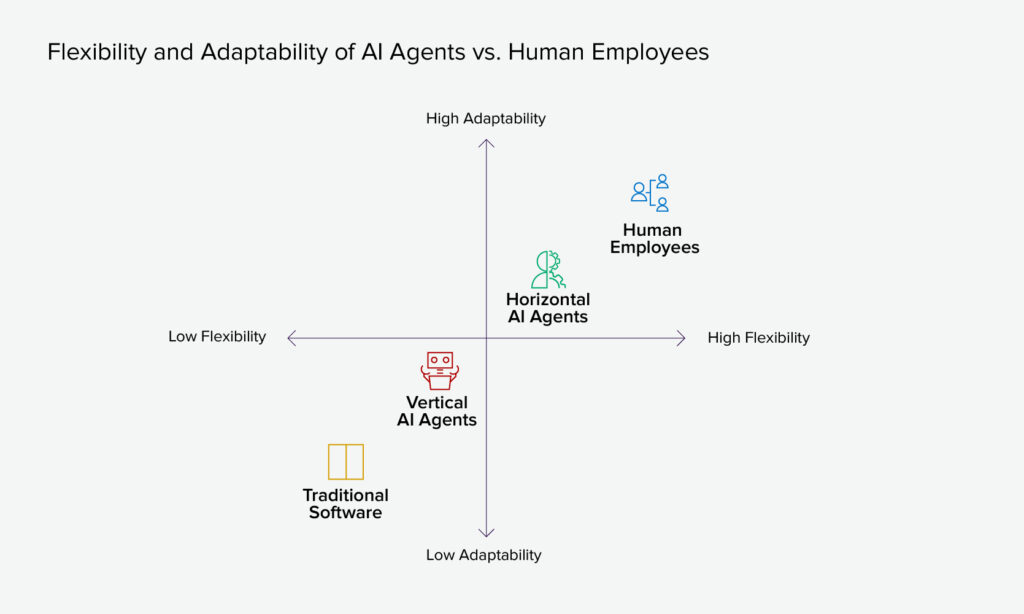
Source: Relevance AI
The main purpose of vertical AI agents is to perform a specific task within a particular department, domain, or industry. They are more of single-purpose assistants that excel at their defined role. For example, these can be AI sales agents that handle tasks typical of a sales manager's routine. Like all types of AI systems, vertical AI agents have their strengths and limitations.
Vertical AI Agents
| Pros | Cons |
| Fast and cost-effective rollout | Limited customization options |
| Expertise tailored to the specific process | Provider dependence |
| Pre-set features | Integration challenges |
Horizontal AI agents, on the contrary, act like flexible team members who can adapt to using new tools and processes within your organization. They're designed to meet your business's unique needs, can handle new responsibilities, and can be easily trained or reconfigured to take on new tasks.
Just like vertical ones, horizontal agents have advantages and disadvantages.
Horizontal AI Agents
| Pros | Cons |
| Customization options | Longer setup time |
| Versatility and adaptability | More upfront effort |
| Scalability | Overkill for simple tasks |
Adaptability is crucial in today’s business world. But to select the right agent type, you need to understand the scope and details of the tasks you plan to delegate. This way, you’ll not only cut unnecessary expenses and reduce stress but also optimize your business processes by leveraging modern AI technologies.
Common AI Agent Use Cases in Business
One key benefit of agentic AI is its ability to make decisions on its own. These agents can grasp complex problems, make informed decisions on their own, think through scenarios, and complete tasks from start to finish. That's why companies across different industries are increasingly adopting this new technology into their daily operations. According to the State of Customer Experience 2024 Report, the financial sector has the greatest potential for agentic AI implementation in the upcoming year.
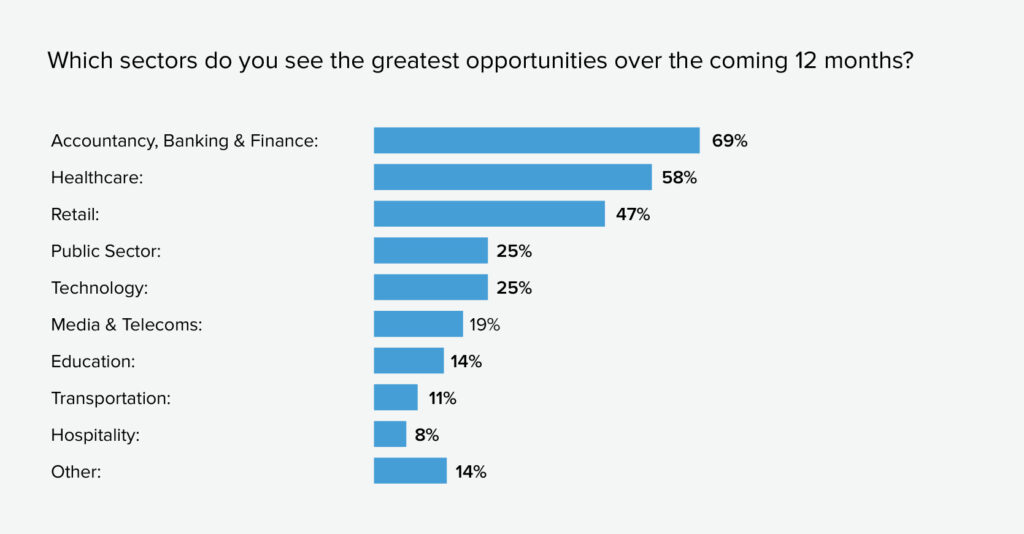
Source: cxtoday.com
Below, you’ll find a more detailed overview of the seven most common current use cases of agentic AI across different sectors.
IT operations and app development
According to Salesforce, 92% of developers say AI agents will help boost their careers.
Agentic AI can help generate large portions of code and offer real-time suggestions to improve coding. They can also automate software testing by creating test cases, executing tests, and analysing results. These tasks speed up development, minimize coding mistakes, and allow developers to focus on more complex problems.
Additionally, to streamline IT operations, AI agents can:
- Automatically detect, diagnose, and resolve IT incidents by analyzing log data, application performance, and system health metrics. They work with other agents or IT tools to implement fixes, minimizing downtime and improving service reliability.
- Manage infrastructure-as-code (IaC) by dynamically provisioning or optimizing resources based on demand. Multi-agent workflows help coordinate security, compliance, and network management tasks, cutting down on manual work.
- Analyze historical data to forecast potential failures before they happen, enabling preventive measures. They constantly update their models with real-time data to improve prediction accuracy.
- Assist with real-time workload balancing by dynamically reallocating resources to improve cost and performance. They simulate various optimization scenarios to align IT resources with business priorities.
Healthcare
AI agents in healthcare serve as proactive partners, helping patients, supporting clinicians, and streamlining administrative workflows to improve patient outcomes and boost operational efficiency.
Some examples of AI agents in healthcare include:
- Streamlined office tasks where agentic AI automates repetitive activities such as appointment scheduling, reminders, insurance claim processing, and record management. Consequently, facilities can cut costs, reduce errors, and free up staff to concentrate on patient care.
- Diagnostic support for doctors by automatically suggesting potential diagnoses and treatment options based on analyzing patient data, such as symptoms, history, lab results, etc. This helps medical workers make more informed decisions quicker, especially in complex cases or limited staffing.
- Customized care and support for patients with chronic conditions using specific wearable devices. When potential risks are identified, AI agents in healthcare can notify patients and providers, schedule follow-up appointments, or adjust medication within approved limits. The outcome is improved illness management and fewer hospital stays.
Financial services
AI tools in general successfully detect fraud in financial services, but agentic AI takes it a step further and manages entire financial processes. For instance, an AI agent can:
- Analyze market data to identify trends and opportunities
- Perform a comprehensive risk assessment by finding the most reliable sources of financial or behavioural data in real time and spotting emerging threats they weren’t initially instructed to search for
- Make investment decisions such as buying, selling, or rebalancing
- Adapt its approach to the market's conditions and the client's financial goals.
Additionally, by implementing AI agents in business, one can handle these customized cases at scale without human supervision, making personalized wealth management more accessible to everyone. These smart assistants can independently identify the best strategies to increase profits, adjusting their approach as needed to seize the right opportunity once it arises. They can research and understand our habits and individual needs to tailor and personalize their service approach.
Retail and eCommerce
An autonomous eCommerce assistant is a key agentic AI example. It manages listings, provides and adjusts prices, and optimizes campaigns automatically. It also analyzes data and user behavior to increase efficiency, boost conversions, and enhance the overall shopping experience.
An AI sales agent is integrated across the retailer’s digital ecosystem, including CMS (Content Management System), supply chain, inventory, advertising channels, and chatbots. Using real-time data like stock levels, click rates, competitor pricing, and customer interactions, the AI sales agent can:
- Automatically refresh or remove products according to stock levels and demand patterns
- Adjust pricing dynamically based on decreasing sales performance or competitor activity
- Run targeted promotions or flash sales when conversion rates fall below a certain threshold.
- Respond to common customer questions using AI-powered live chat with tailored recommendations.
Customer service
Smart assistants can have dynamic conversations with customers about order status, product problems, refund policies, and other complex questions. They can tailor requests based on past interactions to deliver personalized customer care.
Here are the main customer service processes agents can successfully handle:
- Tracking order status
- Handling customer questions
- Managing knowledge resources
- Providing technical support and troubleshooting
- Offering personalized help and recommendations
- Managing process automation
Human resources
In enterprise applications, multiple AI agents work together to automate certain HR functions, either fully or partially. For example, a chatbot with a conversational interface might provide personalized information to an employee asking about company leave policies, while task-based agents handle a series of interconnected tasks like filing paperwork and managing time off requests.
AI agents often integrate with existing systems, such as human capital management platforms, enterprise resource management software, communication tools, and other HR systems. A key advantage of AI agents is that they can autonomously perform complex, multi-step tasks, making them more flexible than previous chatbot or automation technologies.
The most common applications of genetic AI in HR include:
- Streamlining onboarding and training by automating document verification, pre-employment checks, and IT request submissions. AI agents can also personalize training programs and manage user profile creation, making the onboarding experience seamless for new hires. By tailoring learning experiences to employee roles and skill levels, AI can help both new and seasoned team members develop their skills and boost productivity.
- Boosting employee engagement and retention with personalized service delivery models that focus on employee needs. By proactively addressing employee concerns before they happen, AI agents can help improve workplace culture and reduce friction within an organization.
- Accelerating talent acquisition by automating the entire process, from analyzing CVs to creating offer packages. Agents can review large applicant pools, set up interviews, help with candidate evaluation, and leverage generative AI to connect with prospects.
- Enhancing performance management by setting clear, actionable goals and creating employee career development plans, which include identifying potential internal opportunities and highlighting chances for skill growth. With access to employee data, managers can offer timely feedback and analyze productivity, providing suggestions for ongoing improvement.
Logistics
One of the most common AI agents' business impact examples in logistics is the use of autonomous scheduling agents that automatically plan, optimize, and adjust delivery routes without human input. These systems ensure timely deliveries, uphold high service standards, reduce fuel and labor costs, and enable logistics companies to be more flexible and efficient.
The AI agent connects with fleet management systems, warehouse databases, route planning APIs, and customer order platforms. It offers real-time process management by:
- Automatically setting delivery routes and time slots that maximize efficiency, reduce fuel costs, and fulfil customer needs
- Continuously analyzing inventory levels, traffic patterns, driver availability, and package priorities
- Communicating directly with customers about delivery updates and changes through SMS, email, or in-app notifications
- Instantly detecting disruptions such as vehicle delays or route blockages and initiating automatic rescheduling protocols
AI Agents Business Impact Examples
These helpful assistants, when managed properly, bring significant business value to the table of almost any business in any field of activity. Here are the key AI agent automation business benefits worth noting:
- Boosted productivity by making decisions on complex tasks without human involvement
- Enhanced accuracy by self-assessing outputs, identifying gaps, and correcting errors
- Increased availability by operating behind the scenes, such as addressing customer inquiries outside regular working hours
- Lowered costs by eliminating the expensive inefficiencies and mistakes associated with manual processes
- Scalability by adapting to growing task volumes and enhancing operational agility.
Here are some statistics from real-world use cases that back up the positive AI agent business impact examples mentioned earlier:
One of the world's top banks employed AI-powered virtual agents to interact with customers, cutting costs by a factor of 10.
An IT department leveraged AI agents to update its outdated technologies, boosting productivity by as much as 40%.
A biopharma company employed AI agents to generate leads, cutting the cycle time by 25% and boosting time efficiency for drafting clinical study reports by 35%.
Source: bcg.com
Smart agent market continues to grow because of the rising demand for automation and personalized customer experience. To avoid unnecessary details, here’s a chart showing how the AI agent business impact examples mentioned above contribute to its market growth through 2030:
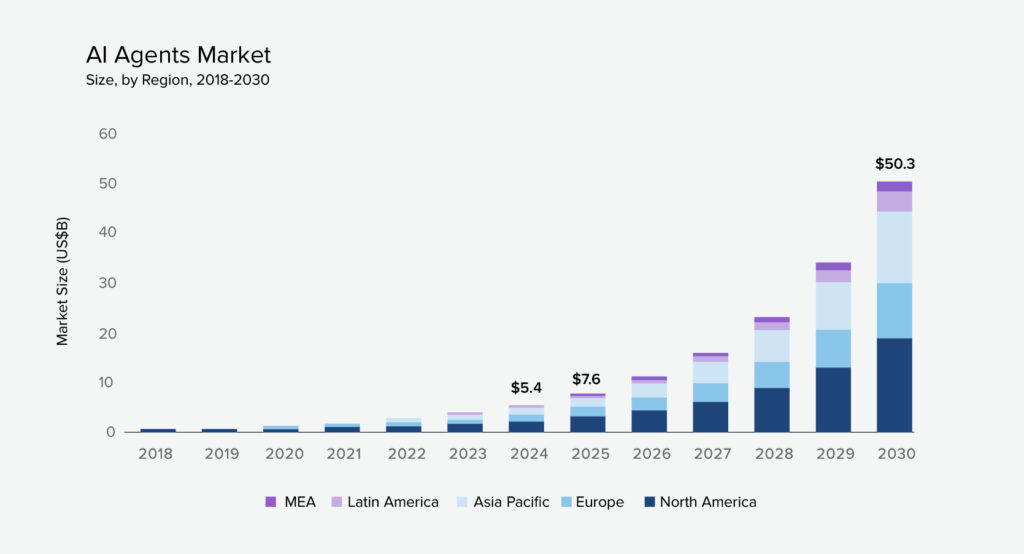
Source: Grand View Research
No matter the industry, smart assistants are definitely worth considering, but despite their obvious benefits, integrating them into existing business operations can present several challenges. For example, an agent is only as good as the data it uses, while cybersecurity will always need at least occasional human oversight. Additionally, AI is evolving rapidly, so it’s essential to build an adaptable environment where your team members are willing to experiment.
Challenges of Implementing AI Agents in Business and Solutions to Them
AI agent implementation is not so black as it is painted; however, it’s wise to be aware of the potential challenges to address and resolve them promptly. First, let’s examine the most common difficulties you’ll probably encounter when integrating these smart assistants into your business processes.
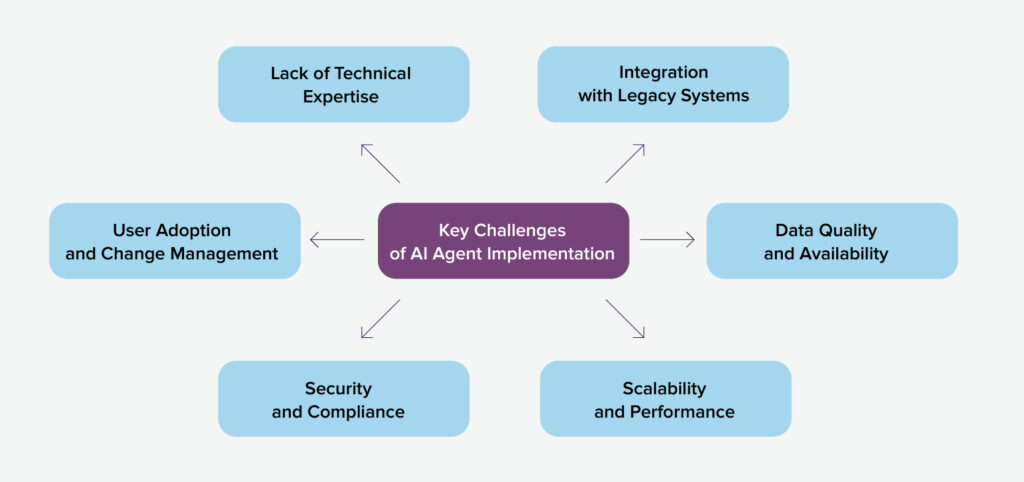
Integration with Legacy Systems
Building something from the ground up is always simpler than modifying legacy systems to enable cooperation with new tools.
❌ Bridging this technological gap is the main challenge in adopting AI solutions overall and AI agents specifically. One major reason outdated legacy systems stick around is their reliability. As they say, “if it’s not broken, don’t fix it”. At first glance, this might seem like a bottleneck for implementing AI agents in business. And that’s the catch.
✅ To tackle this challenge, it is essential to change the way we view the legacy system, seeing it as a launching point rather than a barrier. One approach involves layering AI agents on top of the existing systems using APIs, middleware, and dedicated integration platforms. Here’s a checklist of the steps to successfully bridge the gap between AI and outdated infrastructure:
- Perform a thorough system audit to detect possible compatibility issues.
- Use middleware solutions, as we discussed earlier.
- Take a step-by-step approach rather than integrating everything at once to minimize risks and make the transition smoother.
Data Quality and Availability for Agent Training
Having access to high-quality data specific to a domain is what mainly determines the success of AI agent training.
❌ The issue is that some industries handling highly sensitive data limit access to it for obvious reasons. Besides, new industries may not have sufficient data for a reliable analysis. Outdated or incomplete data sets also pose a risk of generating inaccurate results. With such a limited pool of reliable and accurate information, it’s tough to build trustworthy AI agent models.
✅ To tackle this challenge, select one of the options below:
- Target reputable organizations that offer high-quality, industry-specific data for AI models training.
- Discover how synthetic data works, where AI generates training datasets that mirror real-world scenarios, sidestepping sensitivity concerns.
Another option is to scrape the data yourself, but it’s not the best choice. You’ll spend a lot of time and effort, yet there’s no guarantee that you’ll end up with a reliable AI agent.
AI Agent Scalability and Performance
As businesses rely more heavily on smart agents to drive critical operations, scaling them becomes increasingly important.
❌ Scaling brings its own set of challenges, including upgrading technology stacks, tackling security issues, and combining multiple data sources.
✅ To tackle the challenge of agent scalability and performance, follow the guidelines below:
- Streamline your cloud infrastructure with serverless computing and auto-scaling systems. By doing so, you'll reduce costs and enable your AI agents to handle workloads more effectively.
- Choose low-code platforms to make development easier with smooth integrations and ready-to-use AI components.
- Link multiple AI agents for seamless communication and consistent task completion.
- Continuously update and retrain AI models and keep an eye on data to ensure accuracy and performance.
- Monitor performance to track response times, error rates, and other metrics, ensuring stability and efficiency.
Pro tip
Focus on iterative development — start with a minimum viable product. Test basic use cases first to identify issues early, gather user feedback, and enhance functionality before scaling to more complex tasks.
Security and Compliance
When integrating AI agents in business, remember that they will handle large amounts of personal and sensitive data, making them prime targets for cyberattacks.
❌ The main data protection and compliance challenges include ensuring transparency in AI-driven data processing and preventing unauthorized access or data leaks. Besides, it’s crucial to defend against adversarial attacks and address the lack of clear cybersecurity regulations for AI.
✅ To tackle the challenge, it is necessary to:
- Adopt privacy-first AI models
- Enforce data encryption
- Conduct regular audits of AI systems
- Implement multi-layered security measures
- Perform regular penetration testing
- Comply with ISO 27001 and NIST guidelines
Development Costs and Resource Allocation
Despite AI agent automation business benefits, their development can be a major drain on resources, especially for small businesses. Every stage of development, from establishing the initial environment to long-term upkeep, requires significant financial investment.
❌ Cost overruns often happen when teams underestimate the complexity of creating flexible AI logic. What seems like a simple feature request, can actually require major architectural changes.
In summary, the main cost factors in agentic AI development are:
Data preparation
The virtual assistants you develop depend on high-quality data, but collecting and preparing this data is a complex process. Data needs to be cleaned, organized, and labelled, which requires time and specialized expertise. Outsourcing to vendors might be expensive, building an in-house team takes time, and data management is an ongoing process. Remember that AI models require constant learning through new data, updates, and validation.
Recruiting and retaining talented staff
Creating effective AI agents requires specialized roles, such as data scientists, machine learning engineers, and AI system architects, who are in high demand and earn top salaries. Hiring becomes even tougher when projects need to scale. Certainly, freelancers and consultants can bridge the gap in the short term, but long-term success relies on a team that’s aligned with changing goals. On top of that, investing in training and workshops to upskill existing staff adds unexpected costs to the project’s budget.
Rapidly changing infrastructure demands
Initially, existing hardware or shared cloud resources may be enough. However, as models become more complex and data grows, these setups often fall short. AI training demands high-performance computing, especially for real-time predictions or NLP (Natural Language Processing). Another thing is storage. It’s vital as datasets are expending. Finally, downtime and slow performance also incur costs.
Other overlooked expenses include ongoing agent maintenance, energy consumption, and misaligned goals that result in wasted resources.
✅ To address the challenge, conduct a more informed planning to consider looking at the full cost picture. This way you can optimize financial management and get more accurate predictions about outcomes.
User Adoption and Change Management
❌ Users tend to distrust AI agents because they worry about their data privacy, security, and unclear decision-making processes.
Interesting fact
According to Cisco’s 2023 Data Privacy Benchmark report, 92% of security professionals believe they need to do more to reassure customers that their AI data use is legitimate.
Besides, people often expect smart assistants to act like humans. They misunderstand what virtual assistants can do, which leads to frustration when expectations are not met.
✅ To address these concerns, it is essential to:
- Implement strong data protection measures
- Provide users with a clear and transparent explanation of how AI models process data and make decisions
- Set clear expectations, such as highlighting specific agent use cases, through marketing and onboarding materials.
Lack of Technical Expertise
Training humans is just as important as training AI. People are often reluctant to change, especially when it comes to implementing new technologies into their business routines.
❌ AI agent models with a steep learning curve or an unintuitive interface can overwhelm non-technical users. Generally, complex setup processes lead to low engagement and abandonment, especially for people unfamiliar with Natural Language Processing.
✅ To address this challenge, before implementing AI agents in business processes, consider:
- Preparing guided onboarding for your teammates
- Coming up with context-sensitive tips
- Using conversational AI to make interactions feel natural.
Case Studies of Integrating AI/ML into Existing Business Models
Agentic AI is just one type of AI/ML (artificial intelligence or machine learning system) that helps organizations streamline and automate their business routines. All these systems face similar challenges when being integrated into existing business processes. However, with a smart approach, these roadblocks can be eliminated, leaving only positive outcomes from AI/ML implementation.
Let’s review several examples of how Svitla successfully integrated AI/ML into organizations across various industries, all sharing one common feature: they are now experiencing the benefits of increased efficiency and streamlined business processes.
AI/ML for Video Conferencing Solution (Logitech)
Representatives of the high-tech industry clearly need to tap into the latest technological advancements to drive business growth, and AI/ML is no exception. Logitech, a worldwide leader in video conferencing technology, was looking for a trusted partner to develop several high-impact projects that significantly enhanced Logitech’s product portfolio. Eventually, they chose Svitla Systems as their preferred option.
| Client’s business requirements | Solutions from Svitla Systems | Business impact achieved |
| - Enhance research and development efforts to drive innovations - Build systems that collect data from millions of devices - Design software for smart devices to monitor indoor environments using telemetry - Create cloud-connected desktop apps to manage meeting rooms - Enhance capture capabilities with ML features - Move ML models across platforms and test them on hardware - Integrate advanced people detection. | - Advanced ML and video processing to build a hardware-adaptive ML framework with neural networks and computer vision for real-time people detection and improved conference room videos - Versatile desktop app development to create a scalable, secure, high-performance app supporting new video devices and people detection - Cloud data integration to build a reliable server system with optimized data aggregation, automated setup, and cloud systems to deliver tailored sales and marketing results. | - Powerful analytics for product enhancement - Reduced research time and effort - Faster app development - Boosted overall productivity - Lowered support costs - Improved user experience - Shortened development timelines. |
Read the full case study here.
AI for Medical Coding Solution
Healthcare is one of those essential industries where time efficiency and productivity are vital, not only for business success but also because they directly impact people’s health and even lives. For example, processes such as assigning codes to patient information, diagnoses, and medical procedures, when done manually, carry a high risk of errors and inaccuracies. The healthcare institution needed an AI-driven solution to improve their internal processes, such as medical billing, reduce costs, and boost time efficiency, so they turned to Svitla.
| Client’s business requirements | Solutions from Svitla Systems | Business impact achieved |
| - Accurately assign codes across different code types with limited data samples - Develop an AI solution that requires minimal training for new data - Implement multiple layers of validation for accuracy - Design a system that allows for future improvements - Automate report generation for specific cases - Work with subject matter experts to integrate their expertise. | - AI-driven medical coding to automate code assignment by conducting a thorough patient data analysis - Automated report generation with insights into coding performance and case outcomes - Multi-layer architecture and advanced validation for high precision - Advanced input data processing techniques - Cost-efficiency and scalability optimization using caching strategies. | - Refined accuracy - Adaptable scaling - Flexibility - Budget optimization - Enhanced performance. |
Read the full case study here.
AI/ML for Elderly Care Solution
Just as care brings out the best in people, innovative technologies bring out the best in any business process. An AI-powered platform that provides assistance to caregivers needed to make their processes more interactive and accessible from any location. That's where Svitla Systems stepped in.
| Client’s business requirements | Solutions from Svitla Systems | Business impact achieved |
| - Enhance the app with AI-powered features to provide users with instant access to information on clinics, doctors, and healthcare services - Provide tailored recommendations for elderly care, including treatment options and diagnostic services - Improve support and interaction through a smart chat interface. | - Enhanced chatbot capabilities with OpenAI integration - Core functionality development - Cloud management of bot environment - Chatbot’s memory capabilities upgrade - Vector search implementation for knowledge base - LangChain framework implementation to connect different data sources - Application post-launch optimization. | - Enhanced user engagement - Optimized information accessibility - Supported clients' next growth phase - Enhanced company’s investment appeal by highlighting its AI-driven approach. |
Read the full case study here.
Best Practices for Successfully Implementing AI Agents in Business
And now we’ve reached the main point – key takeaways from the article, presented as a concise step-by-step guide on how to implement virtual assistants into your business processes to achieve the desired outcomes.
Step #1: Define your business requirements and goals
Before choosing and implementing an AI agent into your company’s processes, evaluate your actual business needs and set measurable goals, such as customer support automation or strategic data analysis. This approach allows you to tailor the virtual assistant to your specific organizational requirements.
Step #2: Pick a suitable agent model
In this blog, we explored vertical and horizontal agent categorization. However, many other types of virtual assistants exist, such as customer support chatbots and predictive analytics agents. Conduct research to find the most suitable model for your business scenarios. This will help your company achieve the best possible outcome.
Step #3: Build an agent or select a provider to create one
If you can develop smart assistants with your in-house team – that’s great. Alternatively, look for a trusted provider of AI/ML development services. Choosing the right provider puts you halfway to success because they will manage the entire process and address any unexpected challenges, such as security and compliance, technical expertise shortages, agent scalability, and more.
Step #4: Train your smart agent and team members
Data quality can never be overstated when it comes to training your virtual assistants, especially on real-life scenarios. During this phase, you need to label data, set learning parameters, and run iterative training. As a result, the agent will make accurate decisions and improve over time. Besides, remember to give your team members the training they need to use the smart assistants correctly.
Step #5: Conduct tests to collect feedback
Once the agent is ready, launch it in a controlled setting first. It’s important to keep a close eye on the agent’s performance, collect user feedback, and study how it interacts. By testing, you can identify and fix issues ahead of time, enhance learning, and make sure the smart assistant provides real value before rolling it out to a wider audience. Lastly, you'll need to integrate the new smart agent into your existing business processes, taking into account how to address the common challenges we’ve covered in this article.
Bonus quiz
Should your organization develop AI/ML solutions in-house or partner with experts to achieve your goals? Choose an answer that best matches your organization’s context.
A) We have a robust AI/ML team and infrastructure to build solutions in-house.
B) We need specialized AI expertise to accelerate development and ensure success.
C) We're exploring AI options and want tailored guidance to optimize our strategy.
If your answer is B or C, Svitla Systems is ready to help transform and upgrade your business processes.
Summing Up
AI agents are steadily becoming our teammates in business routine. That’s why they need to be onboarded like human employees to learn their roles, access data, integrate into workflows, and take on responsibilities. Developing smart agents will unlock new business models and boost productivity by automating tasks and freeing workers to focus on more creative endeavors.
However, one shouldn’t blindly rely on virtual assistants. It needs to be controlled optimization with a focus on quality, data security, and cost efficiency. This is where Svitla makes a difference. With its comprehensive AI/ML development services, Svitla Systems handles the entire cycle of development and implementation to transform your business and elevate it to the next level.




